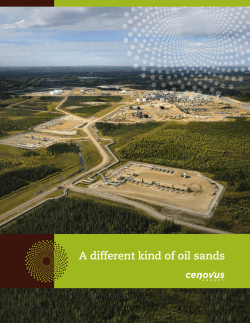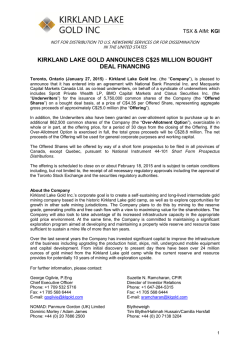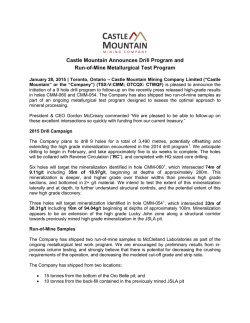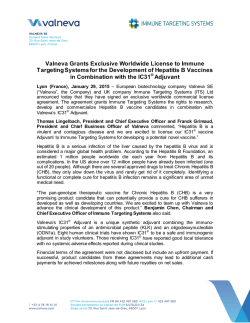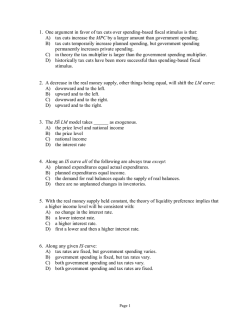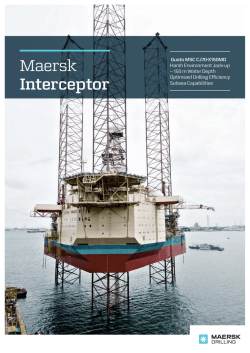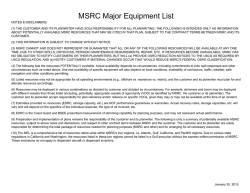
News - Cenovus
Cenovus responds to low oil prices with additional reductions to its capital budget Calgary, Alberta (January 28, 2015) – Cenovus Energy Inc. (TSX: CVE) (NYSE: CVE) is further reducing its 2015 capital spending in order to preserve cash and maintain the strength of its balance sheet. The company has identified approximately $700 million in additional capital expenditures originally planned for 2015 that can be deferred until crude oil prices recover. “We have great assets, we’re in a strong financial position and we have the flexibility in our capital plan to make these additional spending reductions without compromising strategic growth projects,” said Brian Ferguson, Cenovus President & Chief Executive Officer. “Our plan is to continue to pursue our long-term growth strategy, but at a pace we believe is more in line with the current pricing environment.” In December 2014, Cenovus announced a 2015 capital spending budget of between $2.5 billion and $2.7 billion, an approximate 15% reduction from 2014 levels. Since December, crude oil prices have continued to weaken and the company is anticipating prices may remain low through 2015. As a result, Cenovus has revised its 2015 capital budget and is now targeting capital spending this year of between $1.8 billion and $2.0 billion. As part of its prudent approach to financial management, the company will continue to assess its spending plans on a regular basis and has the ability to make further budget adjustments, if required. In addition to capital flexibility, Cenovus continues to evaluate other corporate and financial opportunities, including generating cash from its existing portfolio. In 2015, Cenovus plans to continue funding its optimization program at Christina Lake. Construction of the Christina Lake phase F oil sands expansion and the phase G expansion at Foster Creek, which are each approximately two-thirds complete, are also planned to continue. The expansions are expected to have strong economics, with supply costs for future capital investment at both Christina Lake and Foster Creek, including a 9% return on investment, of between US$40 and US$45 per barrel (bbl) West Texas Intermediate (WTI). Funding has also been allocated to maintain current production from Cenovus’s oil sands assets as well as to continue meeting all maintenance, safety, regulatory and contractual obligations across its portfolio. The planned impacts of the 2015 capital reductions include the suspension of the bulk of the company’s 2015 conventional drilling program in southern Alberta and Saskatchewan and additional spending deferrals on all other longer-dated oil sands expansions and greenfield projects. With its revised spending plans, the company anticipates total crude oil production in 2015 of between 195,000 barrels per day (bbls/d) and 212,000 bbls/d, relatively unchanged from its December 2014 guidance. Cash flow for the year is now expected to be between $1.3 billion and $1.5 billion, based on a WTI strip price of US$50.50/bbl for 2015. Page 1 2015 Budget update Cenovus has a solid hedging program, with 2015 contracts in place for 28,000 bbls/d of Brent crude at an average floor price of about $110/bbl, an additional 7,000 bbls/d of Brent for the first half of the year at an average price of about US$68/bbl and 149 million cubic feet per day (MMcf/d) of AECO natural gas at an average price of just over $3.80/thousand cubic feet (Mcf). “I believe crude oil prices will rebound, but the timing is uncertain. We’re taking the actions we deem prudent to help protect the financial resilience of Cenovus without compromising our future,” said Ferguson. “As a result of the dramatic slowdown across the energy sector, we expect to see continued reductions in demand for labour, service and materials. This should create potential opportunities for us to drive improvements in our cost structure.” In the coming weeks, Cenovus intends to realign its workforce based on its revised spending plans. Where work has been stopped or deferred, the company plans to reassign employees to core business areas and intends to begin reducing the size of its contract workforce. C In addition to the spending reductions outlined above, the company is continuing to pursue opportunities it has identified to target between $400 million and $500 million in sustained annual operating and capital cost reductions in the years ahead. Cenovus has updated its 2015 guidance, available at cenovus.com under ‘Investors.’ Budget forecast1 2015 budget Cash flow2 ($ billions) Per share diluted ($/share) Total capital investment ($ billions) Total oil production (Mbbls/d)4 1 2 3 4 December guidance % change3 -49 1.3 – 1.5 2.6 – 2.9 1.70 – 2.00 3.40 – 3.80 1.8 – 2.0 2.5 – 2.7 -27 195 – 212 197 – 214 -1 2015 based on a WTI strip price of US$50.50/bbl, a WTI/WCS differential of US$14.25/bbl, NYMEX gas of US$3.00/MMBtu, US$/C$ exchange rate at $0.83 and a Chicago 3-2-1 crack spread of US$11.75/bbl. Cash flow is a non-GAAP measure as defined in the Advisory. Percentage change based on the midpoints of the ranges. Includes NGLs production. ADVISORY FINANCIAL INFORMATION Basis of Presentation Cenovus reports financial results in Canadian dollars and presents production volumes on a net to Cenovus before royalties basis, unless otherwise stated. Cenovus prepares its financial statements in accordance with International Financial Reporting Standards (IFRS). Non-GAAP Measure This news release contains references to “cash flow”, which is a nonGAAP measure defined as cash from operating activities excluding net change in other assets and liabilities and net change in non-cash working capital, both of which are defined on the Consolidated Statement of Cash Flows in Cenovus’s interim and annual Consolidated Financial Statements. This measure has been described and presented in this news release in order to provide shareholders and potential investors with additional information Page 2 2015 Budget update regarding Cenovus’s liquidity and its ability to generate funds to finance its operations. For further information, refer to Cenovus’s most recent Management’s Discussion & Analysis (MD&A) available at cenovus.com. FORWARD-LOOKING INFORMATION This document contains certain forward-looking statements and other information (collectively “forward-looking information”) about our current expectations, estimates and projections, made in light of our experience and perception of historical trends. Forward-looking information in this document is identified by words such as “anticipate”, “believe”, “expect”, “plan”, “forecast” or “F”, “target”, “projected”, “could”, “should”, “focus”, “proposed”, “schedule”, “potential”, “may”, “strategy” or similar expressions and includes suggestions of future outcomes, including statements about the flexibility of our capital plan, our growth strategy and related schedules, projections contained in our 2014 and 2015 guidance, long-term total shareholder return, forecast operating and financial results, planned capital expenditures, including the timing and financing thereof, expected future production, including the timing, stability or growth thereof, strength of project economics, improving cost structures, potential dividends and dividend strategy, our financial resilience, forecasted commodity prices, workforce management plans, and our hedging program. Readers are cautioned not to place undue reliance on forward-looking information as our actual results may differ materially from those expressed or implied. Developing forward-looking information involves reliance on a number of assumptions and consideration of certain risks and uncertainties, some of which are specific to Cenovus and others that apply to the industry generally. The factors or assumptions on which the forward-looking information is based include: assumptions disclosed in our current guidance, available at cenovus.com; our projected capital investment levels, the flexibility of our capital spending plans and the associated source of funding; projected supply costs; estimates of quantities of oil, bitumen, natural gas and liquids from properties and other sources not currently classified as proved; our ability to obtain necessary regulatory and partner approvals; the successful and timely implementation of capital projects or stages thereof; our ability to generate sufficient cash flow from operations to meet our current and future obligations; and other risks and uncertainties described from time to time in the filings we make with securities regulatory authorities. Updated 2015 guidance, available at cenovus.com, is based on an average diluted number of shares outstanding of approximately 760 million. It assumes: Brent US$53.50/bbl, WTI US$50.50/bbl; Western Canada Select US$36.25/bbl; NYMEX US$3.00/MMBtu; AECO $2.70/GJ; Chicago 3-2-1 Crack Spread US$11.75/bbl; exchange rate of $0.83 US$/C$. The company’s supply costs reflect an estimated long-term WTI price that provides a project-specific after-tax rate of return of at least 9% on future capital investment. Underlying assumptions in Cenovus’s calculation of supply costs include: price forecast and associated royalties, capital costs, operating expenses, reservoir performance and discount rates. The risk factors and uncertainties that could cause our actual results to differ materially include: volatility of and assumptions regarding oil and gas prices; the effectiveness of our risk management program, including the impact of derivative financial instruments, the success of our hedging strategies and the sufficiency of our liquidity position; the accuracy of cost Page 3 2015 Budget update estimates; fluctuations in commodity prices, currency and interest rates; fluctuations in product supply and demand; market competition, including from alternative energy sources; risks inherent in our marketing operations, including credit risks; maintaining desirable ratios of debt to adjusted EBITDA as well as debt to capitalization (refer to Cenovus’s most recent MD&A available at cenovus.com for definitions and more information regarding debt to adjusted EBITDA and debt to capitalization, which are non-GAAP measures); our ability to access various sources of debt and equity capital; accuracy of our reserves, resources and future production estimates; our ability to replace and expand oil and gas reserves; our ability to maintain our relationships with our partners and to successfully manage and operate our integrated heavy oil business; reliability of our assets; potential disruption or unexpected technical difficulties in developing new products and manufacturing processes; refining and marketing margins; potential failure of new products to achieve acceptance in the market; unexpected cost increases or technical difficulties in constructing or modifying manufacturing or refining facilities; unexpected difficulties in producing, transporting or refining of crude oil into petroleum and chemical products; risks associated with technology and its application to our business; the timing and the costs of well and pipeline construction; our ability to secure adequate product transportation, including sufficient crude-by-rail or other alternate transportation; changes in the regulatory framework in any of the locations in which we operate, including changes to the regulatory approval process and land-use designations, royalty, tax, environmental, greenhouse gas, carbon and other laws or regulations, or changes to the interpretation of such laws and regulations, as adopted or proposed, the impact thereof and the costs associated with compliance; the expected impact and timing of various accounting pronouncements, rule changes and standards on our business, our financial results and our Consolidated Financial Statements; changes in the general economic, market and business conditions; the political and economic conditions in the countries in which we operate; the occurrence of unexpected events such as war, terrorist threats and the instability resulting therefrom; and risks associated with existing and potential future lawsuits and regulatory actions against us. Readers are cautioned that the foregoing lists are not exhaustive and are made as at the date hereof. For a full discussion of our material risk factors, see “Risk Factors” in our most recent Annual Information Form/Form 40-F, “Risk Management” in our current and annual MD&A and risk factors described in other documents we file from time to time with securities regulatory authorities, all of which are available on SEDAR at sedar.com, EDGAR at sec.gov and our website at cenovus.com. Cenovus Energy Inc. Cenovus Energy Inc. is a Canadian integrated oil company. It is committed to applying fresh, progressive thinking to safely and responsibly unlock energy resources the world needs. Operations include oil sands projects in northern Alberta, which use specialized methods to drill and pump the oil to the surface, and established natural gas and oil production in Alberta and Saskatchewan. The company also has 50% ownership in two U.S. refineries. Cenovus shares trade under the symbol CVE, and are listed on the Toronto and New York stock exchanges. Its enterprise value is approximately $24 billion. For more information, visit cenovus.com. Find Cenovus on Facebook, Twitter, LinkedIn, YouTube and Instagram. Page 4 2015 Budget update CENOVUS CONTACTS: Investor Relations Media Susan Grey Director, Investor Relations Brett Harris Media Lead 403-766-4751 403-766-3420 Graham Ingram Senior Analyst, Investor Relations Media Relations general line 403-766-7751 403-766-2849 Anna Kozicky Senior Analyst, Investor Relations 403-766-4277 Steve Murray Senior Analyst, Investor Relations 403-766-3382 Page 5 2015 Budget update
© Copyright 2025
